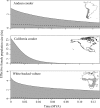Demography of avian scavengers after Pleistocene megafaunal extinction
- PMID: 31273237
- PMCID: PMC6609603
- DOI: 10.1038/s41598-019-45769-w
Demography of avian scavengers after Pleistocene megafaunal extinction
Abstract
The late Quaternary megafauna extinctions reshaped species assemblages, yet we know little about how extant obligate scavengers responded to this abrupt ecological change. To explore whether obligate scavengers persisted by depending on contemporary community linkages or via foraging flexibility, we tested the importance of the trophic interaction between pumas (Puma concolor) and native camelids (Vicugna vicugna and Lama guanicoe) for the persistence of Andean condors (Vultur gryphus) in southern South America, and compared the demographic history of three vultures in different continents. We sequenced and compiled mtDNA to reconstruct past population dynamics. Our results suggest that Andean condors increased in population size >10 KYA, whereas vicuñas and pumas showed stable populations and guanacos a recent (<10 KYA) demographic expansion, suggesting independent trajectories between species. Further, vultures showed positive demographic trends: white-backed vultures (Gyps africanus) increased in population size, matching attenuated community changes in Africa, and California condors (Gymnogyps californianus) exhibited a steep demographic expansion ~20 KYA largely concurrent with North American megafaunal extinctions. Our results suggest that dietary plasticity of extant vulture lineages allowed them to thrive despite historical environmental changes. This dietary flexibility, however, is now detrimental as it enhances risk to toxicological compounds harbored by modern carrion resources.
Conflict of interest statement
The authors declare no competing interests.
Figures


Similar articles
-
Risk effects cascade up to an obligate scavenger.Ecology. 2023 Feb;104(2):e3871. doi: 10.1002/ecy.3871. Epub 2023 Jan 3. Ecology. 2023. PMID: 36116060
-
Multi-locus phylogenetic inference among New World Vultures (Aves: Cathartidae).Mol Phylogenet Evol. 2016 Dec;105:193-199. doi: 10.1016/j.ympev.2016.08.025. Epub 2016 Sep 4. Mol Phylogenet Evol. 2016. PMID: 27601346
-
Mercury and lead exposure in avian scavengers from the Pacific Northwest suggest risks to California condors: Implications for reintroduction and recovery.Environ Pollut. 2018 Dec;243(Pt A):610-619. doi: 10.1016/j.envpol.2018.09.005. Epub 2018 Sep 5. Environ Pollut. 2018. PMID: 30218871
-
Dropping dead: causes and consequences of vulture population declines worldwide.Ann N Y Acad Sci. 2012 Feb;1249:57-71. doi: 10.1111/j.1749-6632.2011.06293.x. Epub 2011 Dec 16. Ann N Y Acad Sci. 2012. PMID: 22175274 Review.
-
Ecological and evolutionary legacy of megafauna extinctions.Biol Rev Camb Philos Soc. 2018 May;93(2):845-862. doi: 10.1111/brv.12374. Epub 2017 Oct 9. Biol Rev Camb Philos Soc. 2018. PMID: 28990321 Review.
Cited by
-
A 14,000-year-old genome sheds light on the evolution and extinction of a Pleistocene vulture.Commun Biol. 2022 Aug 23;5(1):857. doi: 10.1038/s42003-022-03811-0. Commun Biol. 2022. PMID: 35999361 Free PMC article.
-
Bridging Evolutionary History and Conservation of New World Vultures.Animals (Basel). 2023 Oct 11;13(20):3175. doi: 10.3390/ani13203175. Animals (Basel). 2023. PMID: 37893899 Free PMC article.
-
Origin of the Laurentian Great Lakes fish fauna through upward adaptive radiation cascade prior to the Last Glacial Maximum.Commun Biol. 2024 Aug 12;7(1):978. doi: 10.1038/s42003-024-06503-z. Commun Biol. 2024. PMID: 39134631 Free PMC article.
-
Andean and California condors possess dissimilar genetic composition but exhibit similar demographic histories.Ecol Evol. 2020 Oct 21;10(23):13011-13021. doi: 10.1002/ece3.6887. eCollection 2020 Dec. Ecol Evol. 2020. PMID: 33304512 Free PMC article.
References
-
- Anderson, A. Who’s who in the Pleistocene: A mammalian bestiary. In Quaternary extinctions: a prehistoric revolution (eds Martin, P. S. & Kleins, R. G.) 40–89 (University of Arizona Press, 1984).
Publication types
MeSH terms
Substances
LinkOut - more resources
Full Text Sources
Miscellaneous

